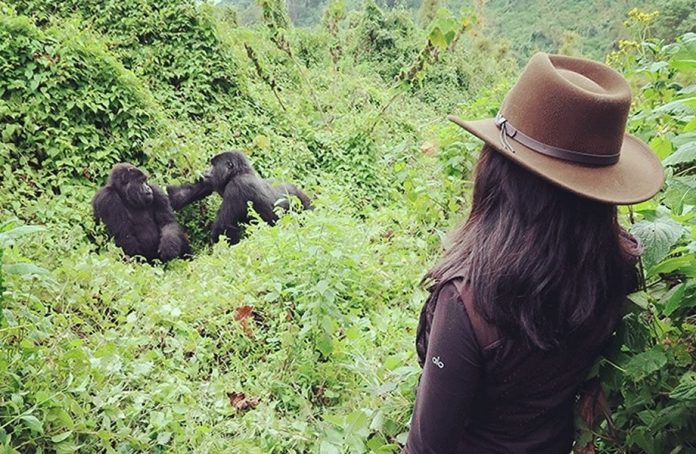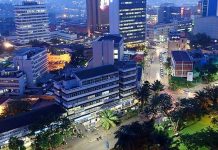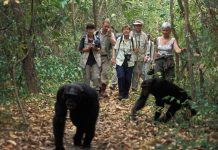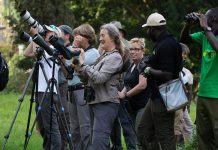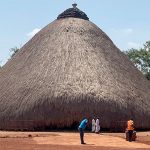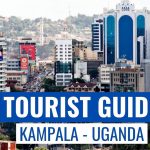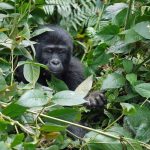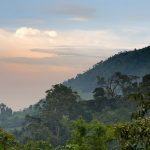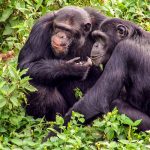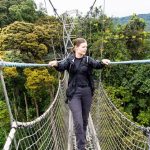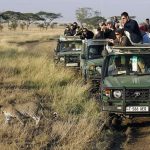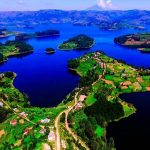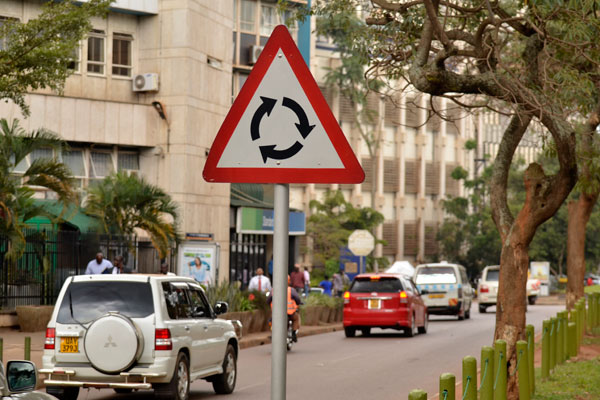Mountain gorillas (Gorilla Beringei Beringei) are one of those critically endangered primates currently inhabiting the jungles of Eastern and Central Africa. These incredible creatures share up to 98% of human DNA and it is an unimaginable encounter to be amidst them in their natural habitat.
Mountain gorillas currently occupy the dense forests of Uganda’s Bwindi Impenetrable National Reserve and the slopes of the dormant Virunga mountain massif which spans across Rwanda’s Volcanoes National Park, Uganda’s Mgahinga Gorilla National Park, and Virunga National Park in the eastern region of the Democratic Republic of the Congo.
Where is Gorilla trekking Carried Out?
Yes, there is gorilla trekking in the impenetrable jungles of eastern and central Africa where one can watch in admiration one of the most endangered primates in their natural habitat.
A gorilla trekking tour is a highlight of why travelers visit this part of the world, specifically Uganda, Rwanda, and the Democratic Republic of Congo. And nowhere else in the world can one indulge in this magnificent wildlife adventure.
Which destinations can I go for gorilla trekking?
Africa is a magical continent, filled with abundant nature, diverse culture, a variety of wildlife, and varied relief and vegetation. And most importantly, it is a safe haven for critically endangered mountain gorillas.
It is only in Africa where travelers can meet and stay with mountain gorillas in the wilderness. This remarkable adventure comes once in a lifetime and is only found in Uganda, Rwanda, and the Democratic Republic of Congo. These countries are located in the eastern region of Africa and are famous for harboring these unique species.
Gorilla trekking safaris in these countries come in handy with numerous other wildlife tours, including birding, cultural and hiking trips.
The countries boast a total of 3 national parks which shelter over 1000 mountain gorillas altogether, and these include Mgahinga and Bwindi national parks in Uganda, Virunga national park in D. R. Congo, and Volcanoes national park in Rwanda.
All these parks have a total of over 25 gorilla families, which have been fully habituated and have been a center of attraction for travelers all over the world.
Are there accommodation facilities in these gorilla destinations?
The national parks offer a range of selected luxury properties with breathtaking views of the Virunga massif, a chance of mountains to which these parks belong.
The magnificence and serenity provided by these lodges offer ultimate experiences to complement a gorilla adventure trip.
The notable lodge options include luxury, mid-range, and budget properties and some camping options; all come with great hospitality, perfect setting, and excellent facilities.
What time does the gorilla trekking tour start?
A typical gorilla trekking tour whether in Uganda, Rwanda, or DR. Congo starts as early as 8:00 am with a briefing from the guides who will remind you of what to do and what not to do during the trekking experience.
The morning hours are better because that’s when gorillas can be just leaving their nests as they go looking for their daily food, during afternoon and evening hours, they are always relaxing.
What is the climate in the gorilla trekking regions?
This part of Africa is blessed with a pleasant and friendly climate and weather all year through. The weather is cold most especially at night, and temperatures can drop up to 10⁰C and during the day it may range from 17⁰-20⁰C. One is advised to carry a jacket /jumper /sweater to serve the changing climate.
Items to carry while on a gorilla trekking safari?
Rain jackets and sweaters or jumpers in case it rains,
You can also carry a camera and an extra battery
Water-resistant bags to protect your devices from the effects of water in case it rains.
Insect spray,
Face masks
At least two liters of water
Packed lunch since it’s an activity that is most likely to take the whole day.
Gloves; – are useful for grabbing bushes
Walking stick – provided by the camp
What are the best clothes to put on during gorilla trekking?
Make sure you put on -Trekking/Hiking boots,
Long-sleeved shirts
A pair of long stockings
Trousers
Bush hat that bare a brim for sun protection
And also a sweater to keep you warm
How fit do you need to be to do the Gorilla trek?
If you can put a foot in front of the other for some hours, it means you can do this. The guides are there to walk with you at the pace you can manage. However, it needs some average fitness, depending on the movements of the gorillas and a specific gorilla family allocated to you, as some families tend to dwell deep in the jungles while others are easily accessed just a few hours from the starting point.
However, there is no guarantee that one will see the gorillas because sometimes they can hide inside the forests but the guides will always ensure you don’t leave the forest without seeing these highly elusive apes.
How much does it cost to see gorillas?
For anyone to carry out a gorilla trekking safari, they require a permit that allows them to access the park. However, this comes at a cost; the gorilla permit cost varies from country to country.
Rwanda is still the most pricy destination as far as gorilla trekking is concerned and in May 2017, permit prices were doubled from 750$ to 1500$ making it the most expensive gorilla permit in Africa and the world.
Uganda still stands at USD 600 per permit in both Mgahinga and Bwindi national parks while gorilla habituation, an experience to stay with gorillas for up to 4 hours goes for 1,500$ per individual.
Unlike her neighbors Uganda and Rwanda, D.R. Congo has kept prices for gorilla permits as low as 400$ per person in both Kahuzi-Biega and Virunga national park.

